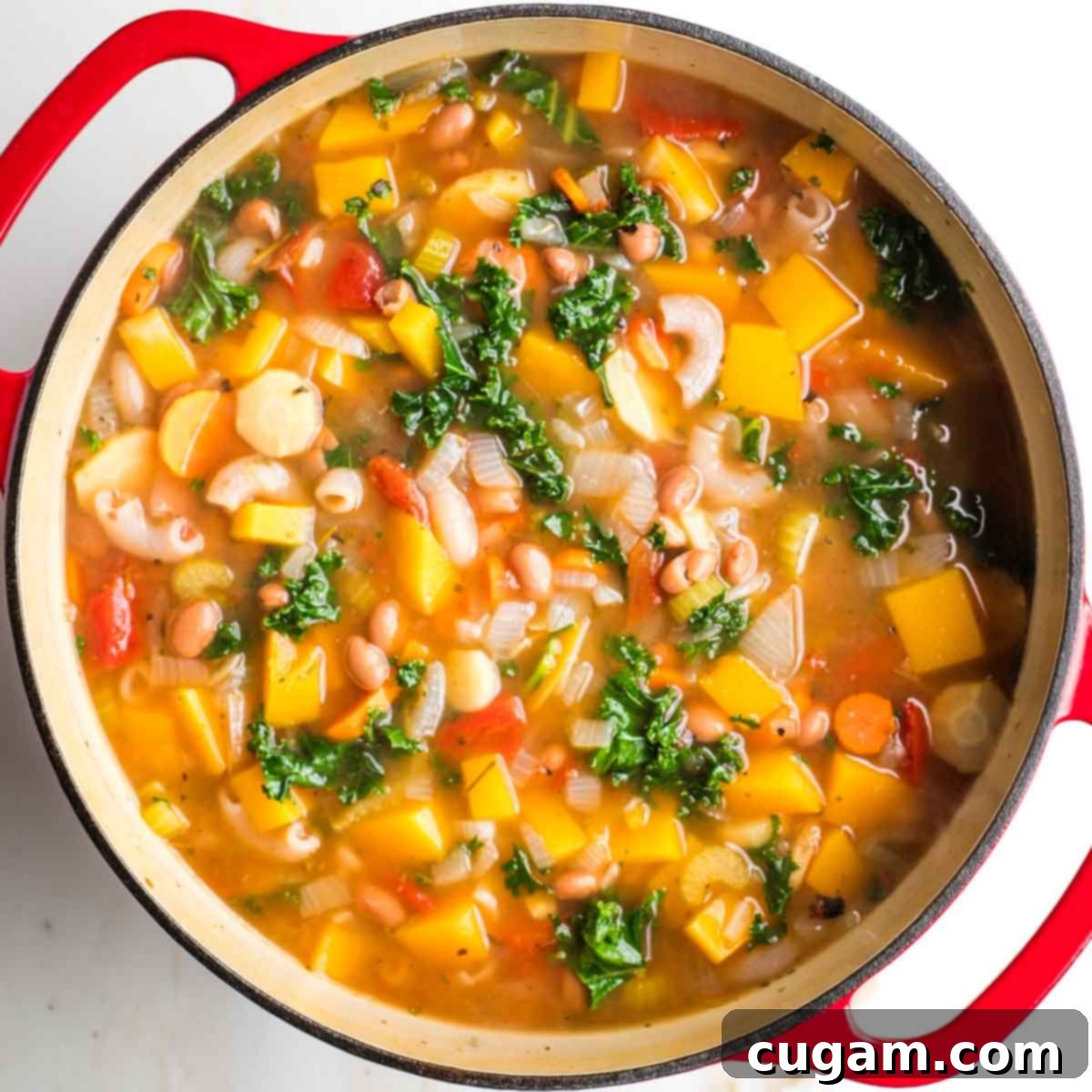Hearty Vegan Fall Minestrone Soup with Butternut Squash & Kale: The Ultimate Autumn Comfort Food
Embrace the cozy flavors of autumn with this incredibly hearty and satisfying **Fall Minestrone Soup**. Crafted with sweet butternut squash, nutrient-dense kale, and a medley of earthy root vegetables, all simmered in a robust and rich vegan broth, this soup is the epitome of comfort food. Not only is it deliciously flavorful, but it’s also packed with nutrition, making it an ideal meal for the colder months. Plus, this easy vegan soup recipe is fantastic for meal prep, incredibly budget-friendly, and a guaranteed crowd-pleaser for the whole family!
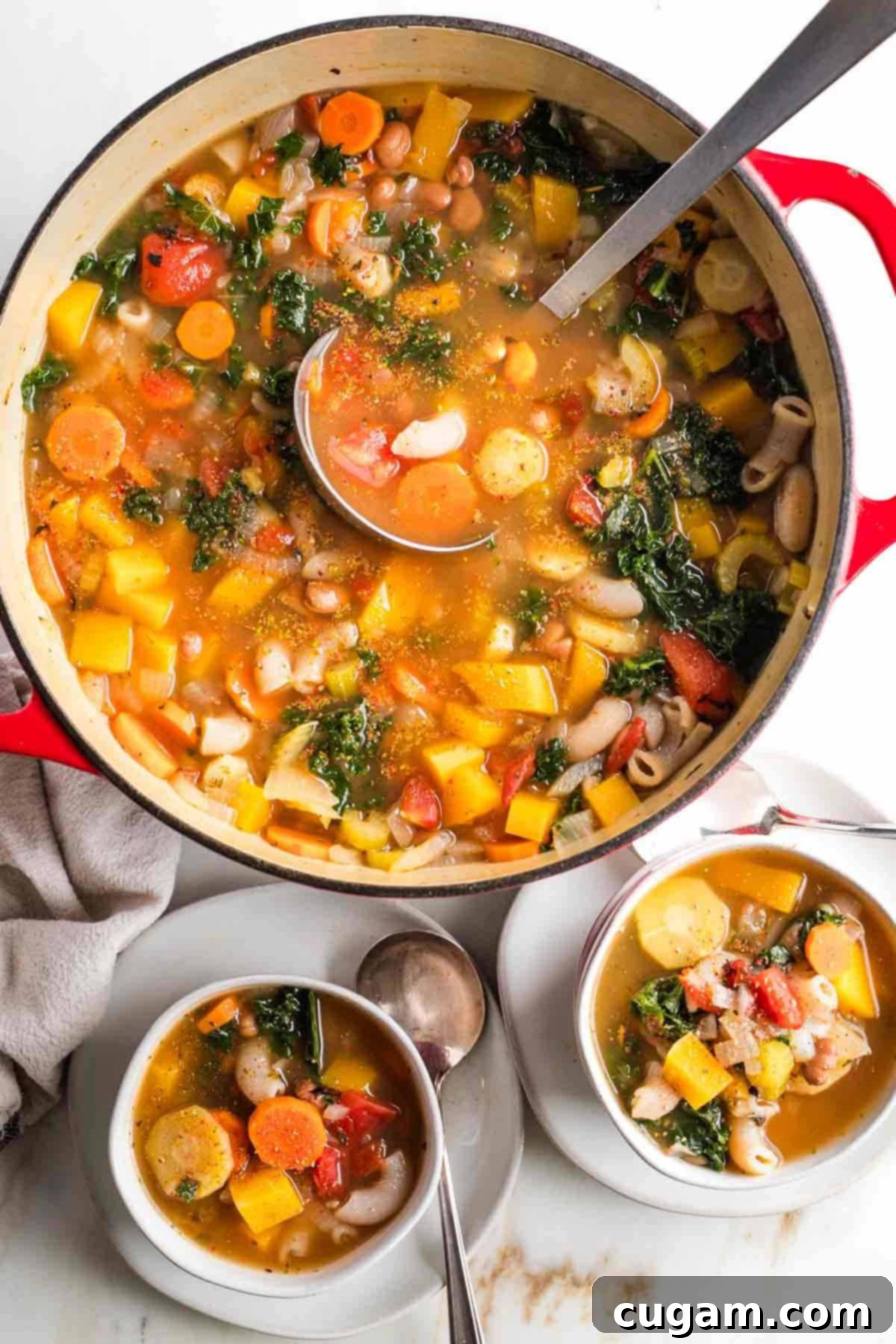
As the leaves change and temperatures drop, the fall harvest blesses us with an abundance of winter squashes, perfect for crafting vibrant and satisfying autumn soup recipes. While pureed butternut squash soup often comes to mind as an obvious choice, this easy, chunky, and meatless minestrone offers a wonderfully different and equally delicious way to enjoy the seasonal goodness of butternut squash in a soup. It’s a delightful alternative that highlights the texture and natural sweetness of the squash.
Our **Vegan Minestrone Soup** is generously loaded with the best of seasonal vegetables, including the star ingredients like tender butternut squash and vibrant kale, alongside classic carrots and parsnips. To boost its nutritional profile and make it a complete meal, we’ve added hearty beans for plant-based protein and fiber. The secret to its exceptional depth of flavor lies in a delicious easy homemade vegetable broth, ensuring every spoonful is bursting with taste. This isn’t just another plant-based dinner; it’s a comforting, wholesome meal that everyone, regardless of dietary preference, will truly love!
Key Ingredients for Your Autumn Minestrone
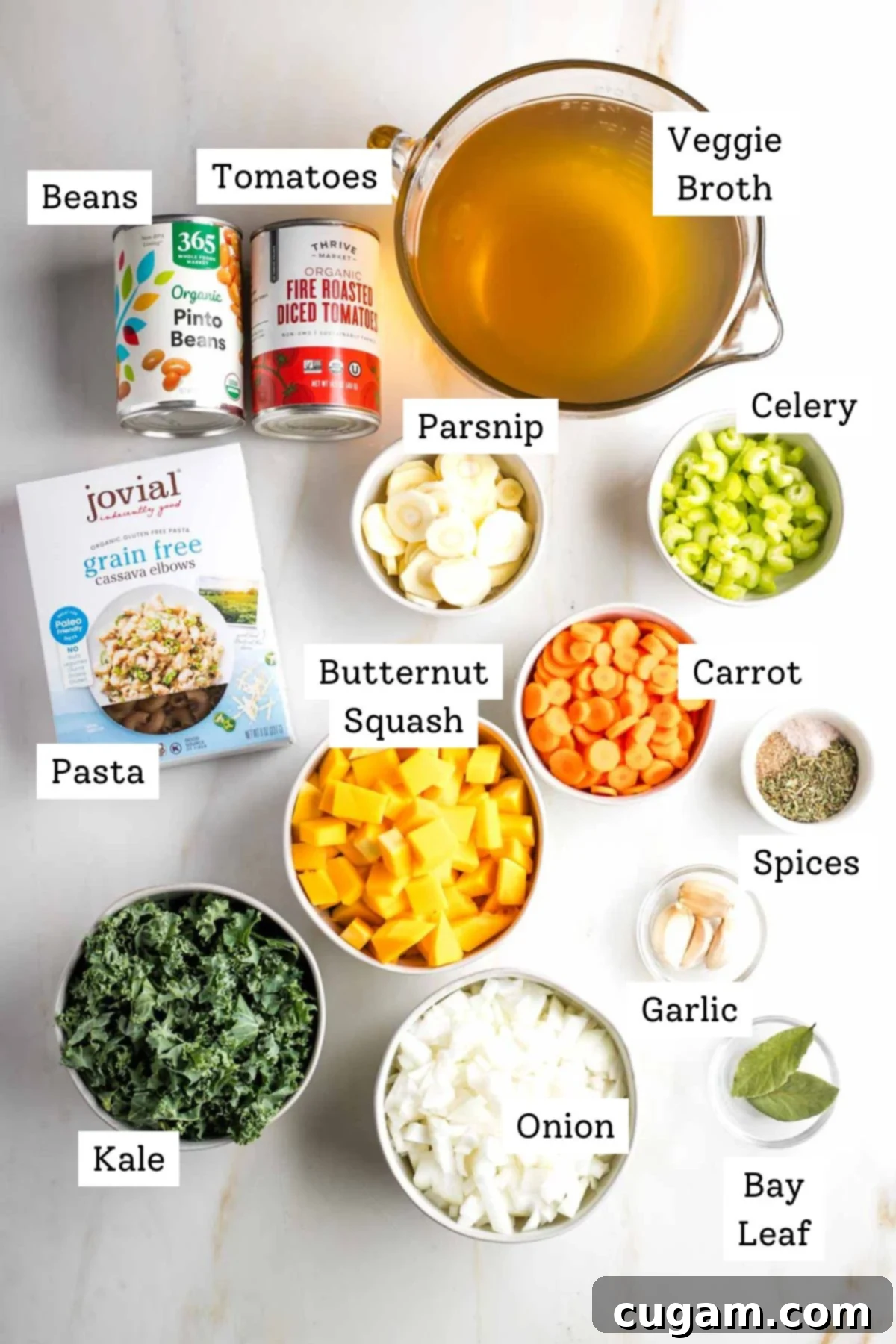
Crafting the perfect minestrone starts with selecting high-quality, fresh ingredients. Here’s a closer look at the components that make this soup sing, along with some helpful tips for substitutions and selection:
- Beans: Beans are a cornerstone of any hearty minestrone, providing essential plant-based protein and an abundance of fiber. This combination is fantastic for helping to regulate blood sugar levels and promoting long-lasting satiety, keeping you feeling full and satisfied. Good choices include classic pinto beans, kidney beans, chickpeas, or white beans (like cannellini or navy beans). Essentially, whatever type of canned or cooked beans you have readily available in your pantry will work beautifully. Just remember to rinse and drain them thoroughly before adding to the soup.
- Butternut Squash: The star of our fall-themed minestrone, butternut squash lends a wonderful sweetness and creamy texture to the soup. If butternut squash isn’t available or if you prefer a different flavor profile, any hard winter squash will work well. Consider options like acorn squash, kabocha squash, hubbard squash, or even fresh pumpkin (not pie filling). Sweet potatoes or yams are also excellent alternatives, offering a similar sweetness and a slightly different nutritional boost. When selecting, look for squash that feels heavy for its size and has a deep, uniform color.
- Vegetable Broth: The broth forms the foundation of your soup’s flavor. I highly recommend making your own easy homemade vegetable stock and keeping it frozen in batches for convenient soup preparation. Homemade broth allows you to control the sodium content and ensures a fresher, richer flavor without artificial additives. If you opt for store-bought veggie stock, always make sure to read the ingredient list carefully to avoid highly processed vegetable oils, excessive sodium, and unwanted preservatives. Look for low-sodium or unsalted varieties to adjust seasoning to your preference.
- Pasta: Pasta adds a delightful chewiness and makes the soup even more substantial. I personally used Jovial Brand Grain-free Cassava elbow pasta, which holds up wonderfully. You can substitute with any small pasta shape that meets your dietary needs, such as ditalini, small shells, or gluten-free alternatives like lentil or chickpea pasta. A crucial tip: be sure to cook the pasta separately and for slightly less time than the package calls for (al dente). This prevents it from becoming mushy when added to the soup and absorbing too much broth, ensuring a perfect texture.
- Kale: For this hearty minestrone, opt for robust greens that can withstand simmering without completely disintegrating. Hearty greens like Swiss chard, collard greens, red or green curly kale, lacinato kale (also known as Tuscan or dinosaur kale), or turnip greens are all excellent choices. These varieties will wilt beautifully, adding a tender, nutrient-rich element without becoming overly soft or slimy, maintaining a pleasant texture in every bite.
Why Kale is a Superstar in Soup Recipes
Kale isn’t just a trendy superfood; it’s a deeply nutritious and versatile green that shines in many dishes, especially hearty soups like this Fall Minestrone. Its robust nature makes it particularly well-suited for simmering, where other more delicate greens might wilt into oblivion.
- This **Fall Harvest Minestrone** is an excellent way to eat seasonally while harnessing the incredible energy and nutrients available from greens to create a balanced and wholesome meal. Kale adds a vibrant color and a slightly peppery flavor that complements the richness of the root vegetables and squash.
- **Tuscan Kale** (also widely known as Lacinato kale or by some as “dinosaur kale” due to its crinkly texture) is particularly fantastic for soups. It’s much less fragile than other tender greens, meaning it won’t completely fall apart even with extended cooking. Beyond its texture, it is absolutely loaded with nutrition, making it a powerful addition to your diet.
- As a nutritional powerhouse, kale is a significant source of essential Vitamins K, C, and B6. It is also an excellent source of Thiamin, Riboflavin, and Iron. These nutrients support bone health, immune function, energy production, and overall well-being. Furthermore, kale is rich in antioxidants and anti-inflammatory compounds, contributing to its status as one of the healthiest vegetables you can eat.
- I particularly appreciate kale’s heartiness when adding it to soup. I’m not a fan of soggy greens, but a Tuscan kale that has perfectly wilted, retaining a bit of its structural integrity and flavor? Sign me up! It adds a fantastic textural contrast and a burst of fresh flavor at the end.
Step-by-Step: Crafting Your Fall Minestrone
Making this hearty Fall Minestrone is a straightforward process, focusing on building layers of flavor. Follow these steps to create a delicious and comforting soup:
Begin by preparing your aromatic base: finely dice the yellow onion, thinly slice the celery, carrots, and parsnips. For the garlic, either finely grate it using a microplane or use a garlic press for ease and maximum flavor distribution.
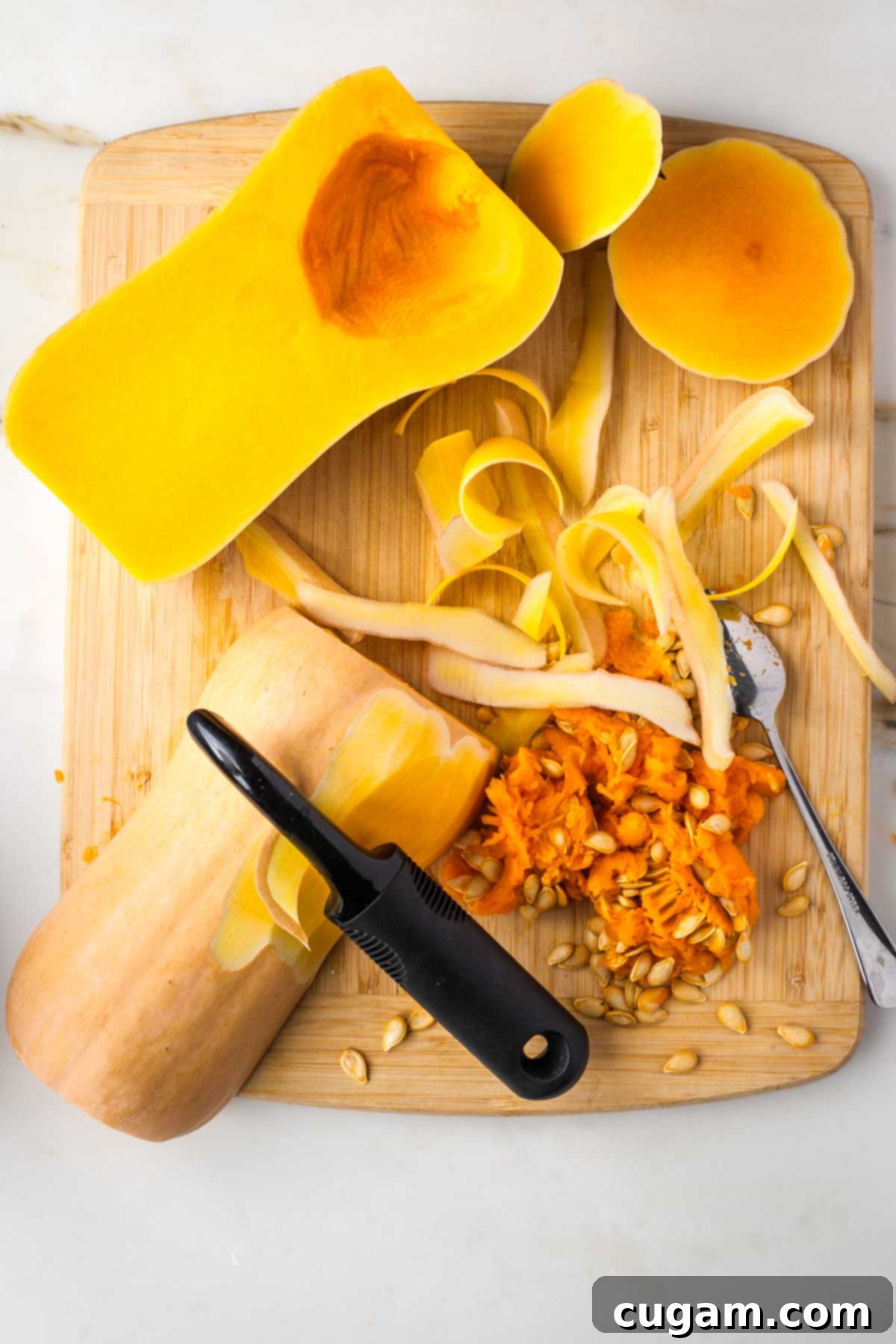
For the butternut squash, first trim a thin slice off both the top and bottom ends to create stable surfaces. Cut the squash in half lengthwise, then scoop out the seeds and fibrous strands (a grapefruit spoon can make this surprisingly easy!). Then, use a sturdy vegetable peeler to easily remove the tough outer skin. For a quick tip, if the squash skin is too hard to peel, you can microwave it for 1-2 minutes to soften it slightly before peeling.
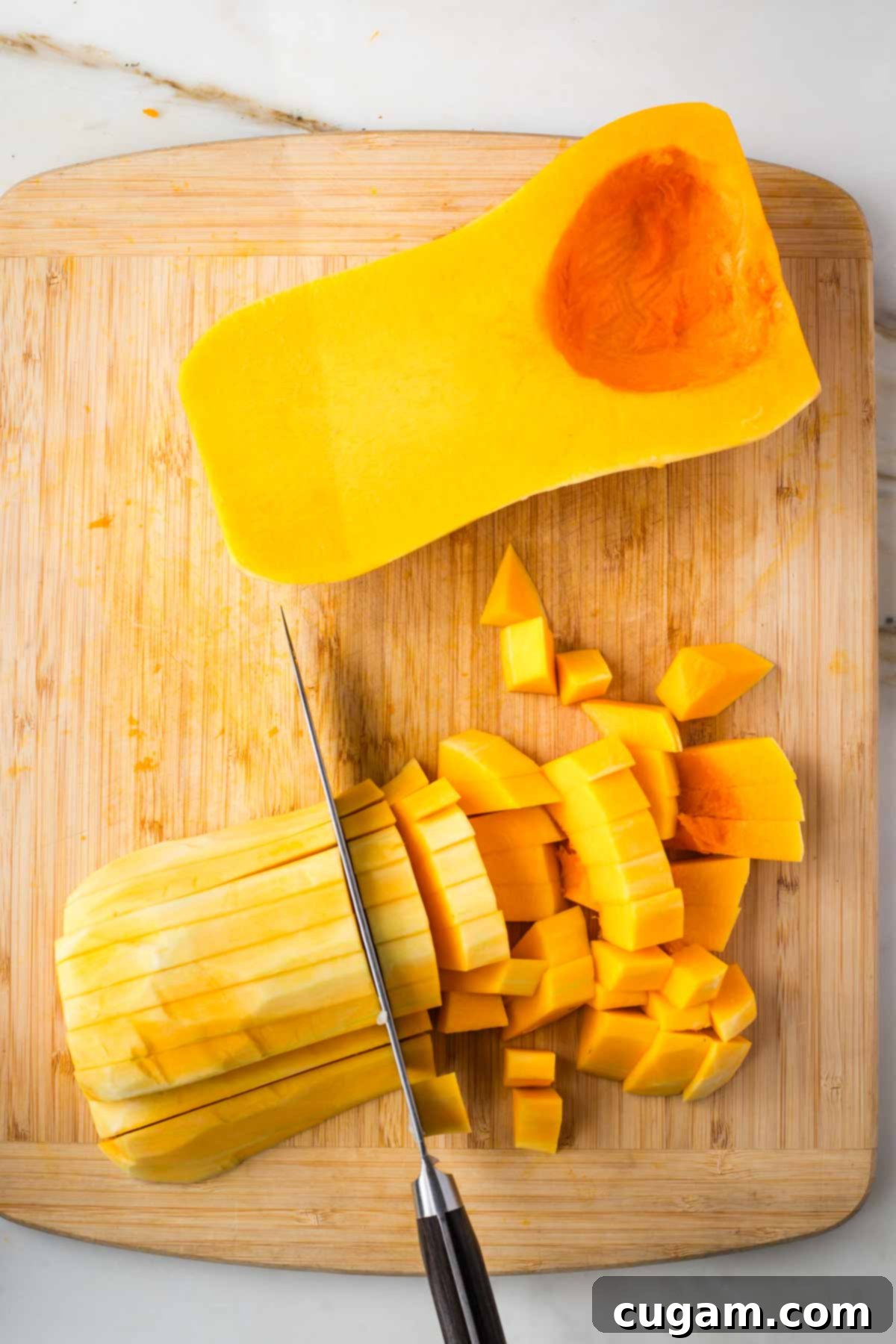
Once peeled, place the halved squash cut-side down on a cutting board for stability. Make even ¼-inch lengthwise slices, then turn the squash and cut in the other direction to create small, uniform cubes. Uniform dicing ensures that the squash cooks evenly and blends well with the other chunky vegetables in the soup.
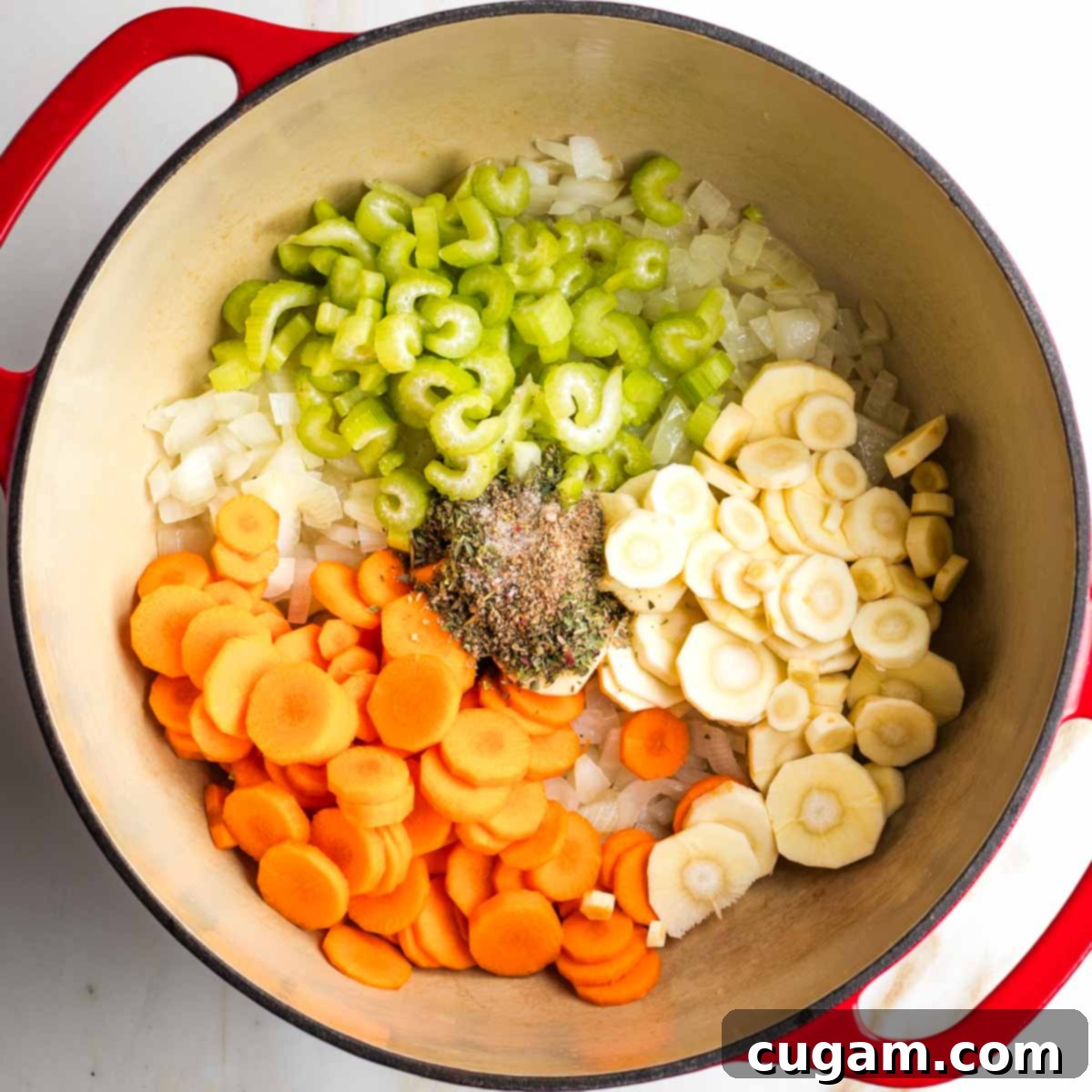
Heat a Dutch oven or a large soup pot over medium heat. Add a tablespoon of olive oil or a splash of veggie broth (for an oil-free option) and sauté the diced onion until it becomes translucent and begins to soften, which usually takes about 3-5 minutes. This step creates the flavorful foundation for your soup. Next, add the carrots, celery, parsnips, and your Italian spices. If you used my no-salt veggie broth recipe, you may need to add additional salt at this stage or to taste later to ensure the vegetables are well-seasoned.
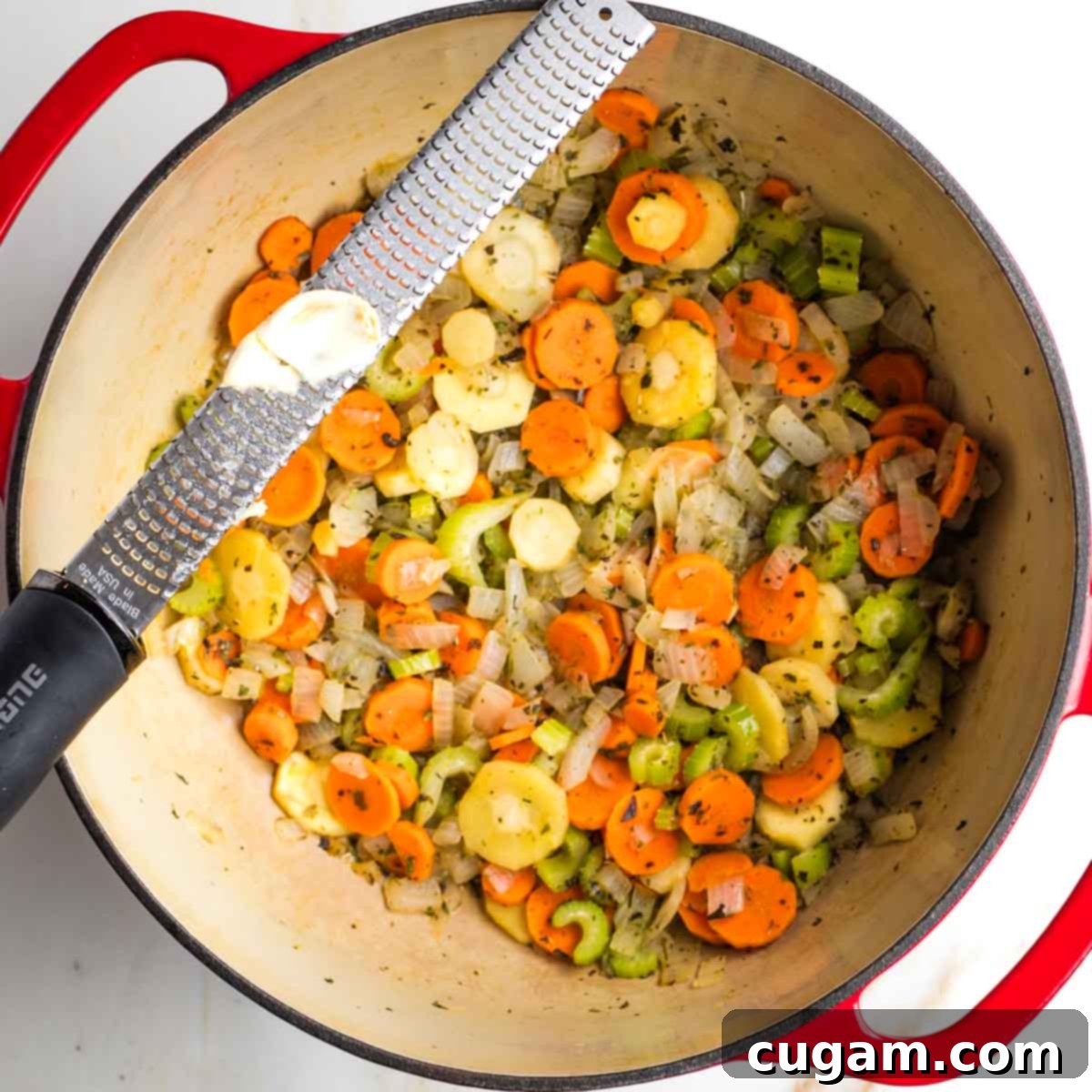
Continue to cook and stir the vegetables for about 5-7 minutes, until they are tender-crisp. To prevent sticking and deglaze the bottom of the pot, add veggie broth one tablespoon at a time as needed. Once the vegetables are tender, use a microplane or garlic press to add the minced garlic directly over the pan. Stir it in well and cook until fragrant, which typically takes a quick 30 seconds to prevent burning.
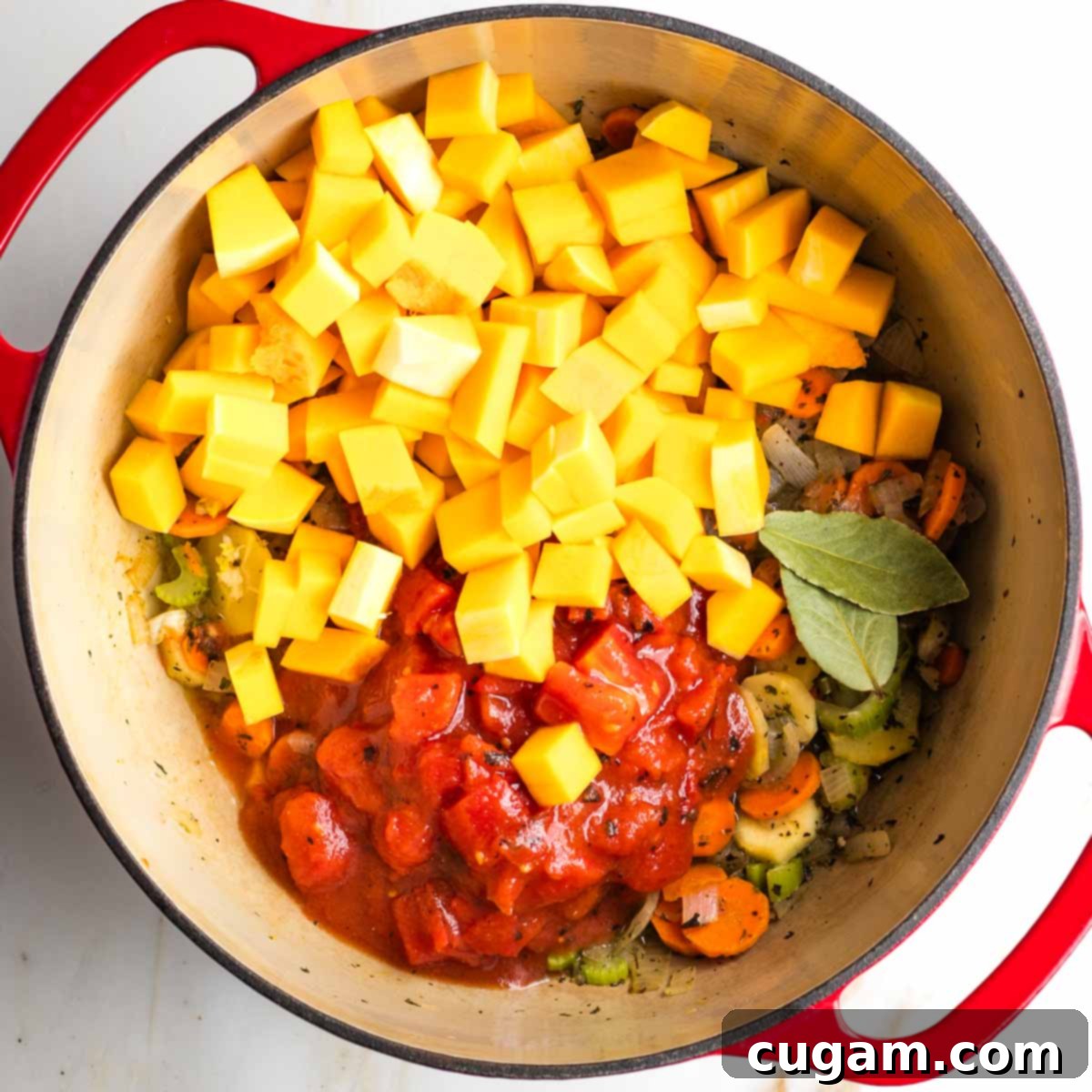
Next, pour in the canned diced tomatoes with their flavorful juices. Add the prepared winter squash cubes and two bay leaves to the pot. The bay leaves will infuse the soup with a subtle, aromatic depth during the simmering process.
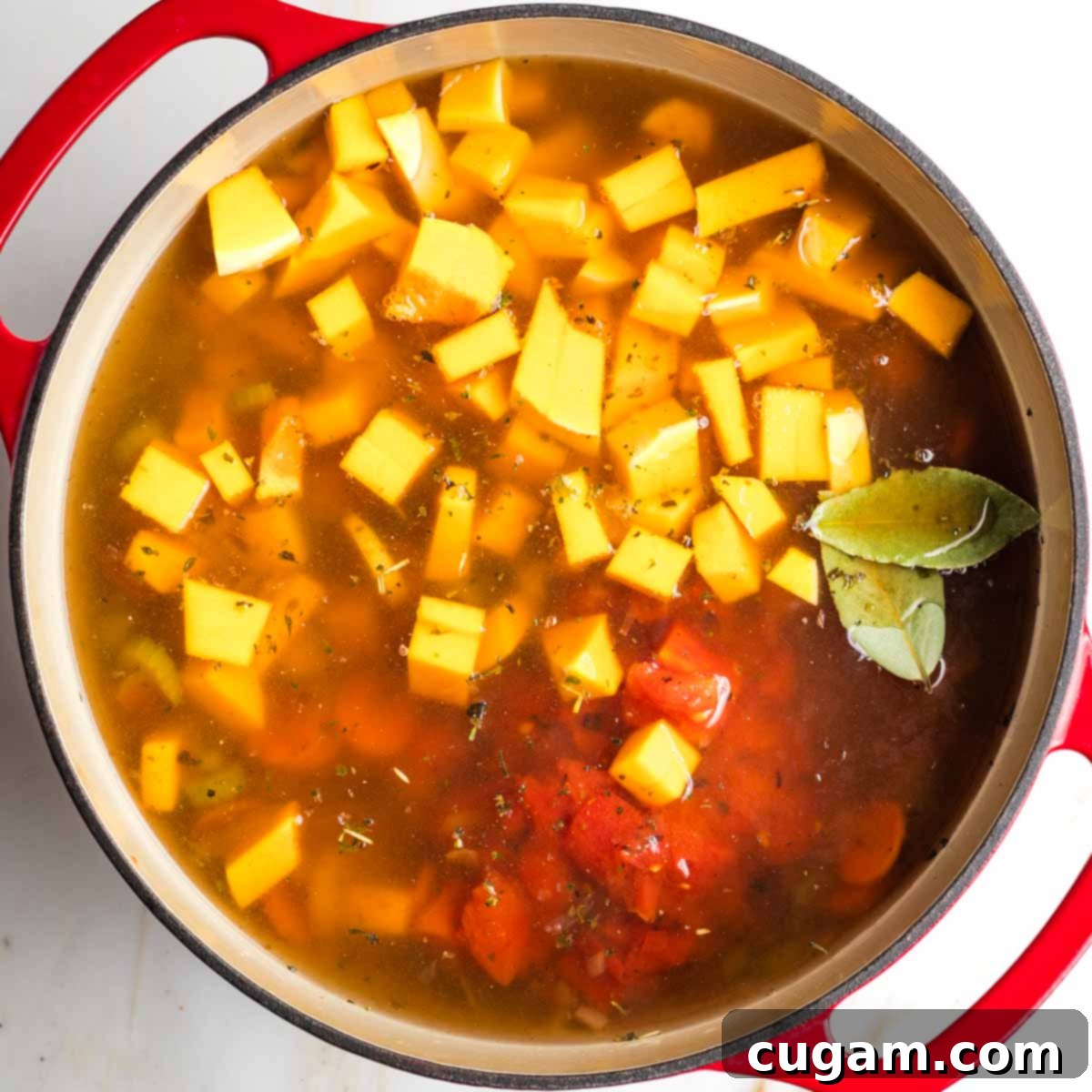
Pour in the vegetable stock, ensuring all the ingredients are well-submerged. Stir everything thoroughly to combine. Bring the soup to a gentle simmer, then reduce the heat to maintain a steady, low simmer. Meanwhile, in a separate pot, cook your chosen pasta for about 2 minutes less than the package directions recommend to ensure it remains al dente and doesn’t get mushy when added to the soup later.
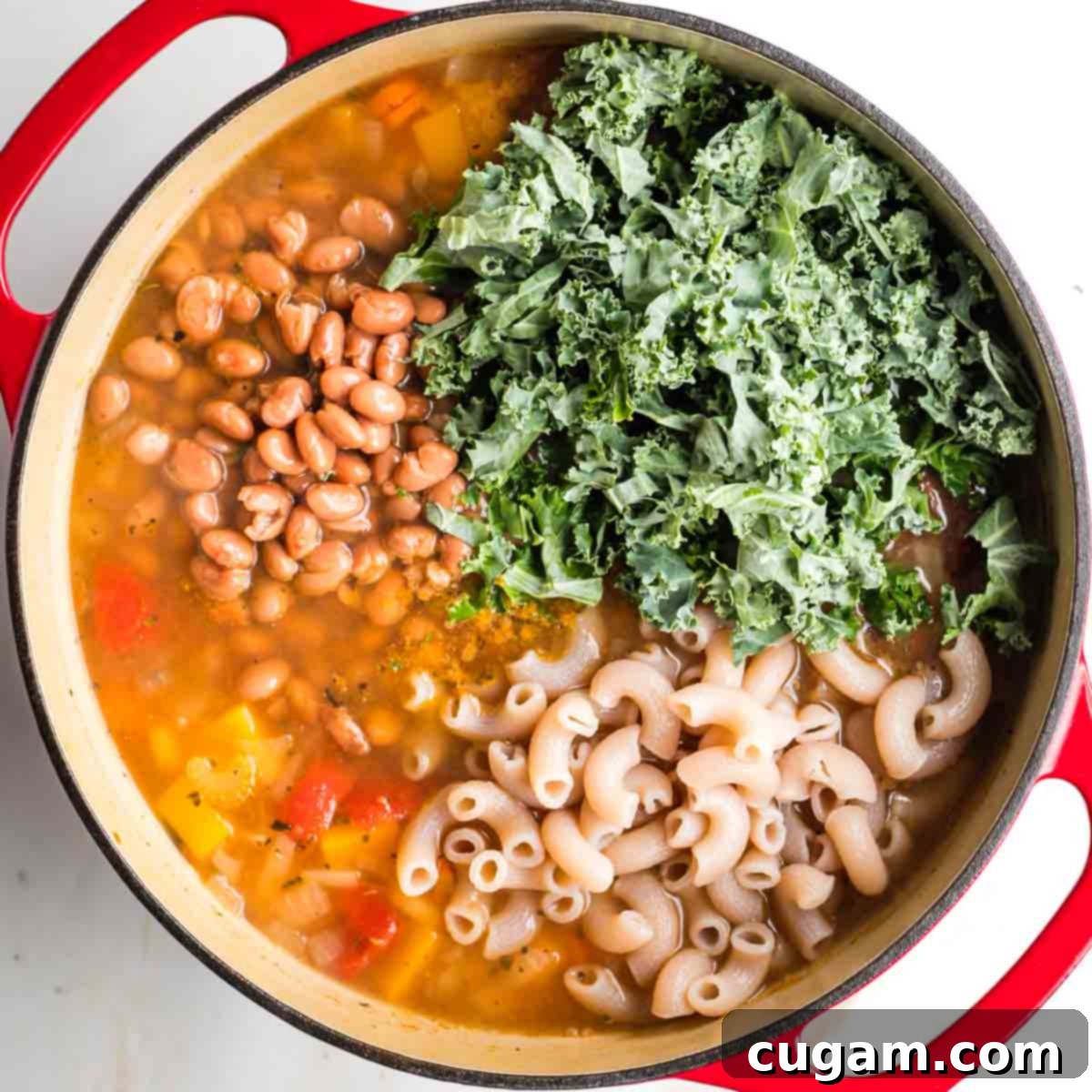
Allow the soup to simmer for approximately 20 minutes, or until the butternut squash cubes are fork-tender. Once the squash is cooked to your liking, add the separately cooked and drained pasta, the rinsed and drained beans, and the roughly chopped kale to the pot. Stir gently to combine all the ingredients.
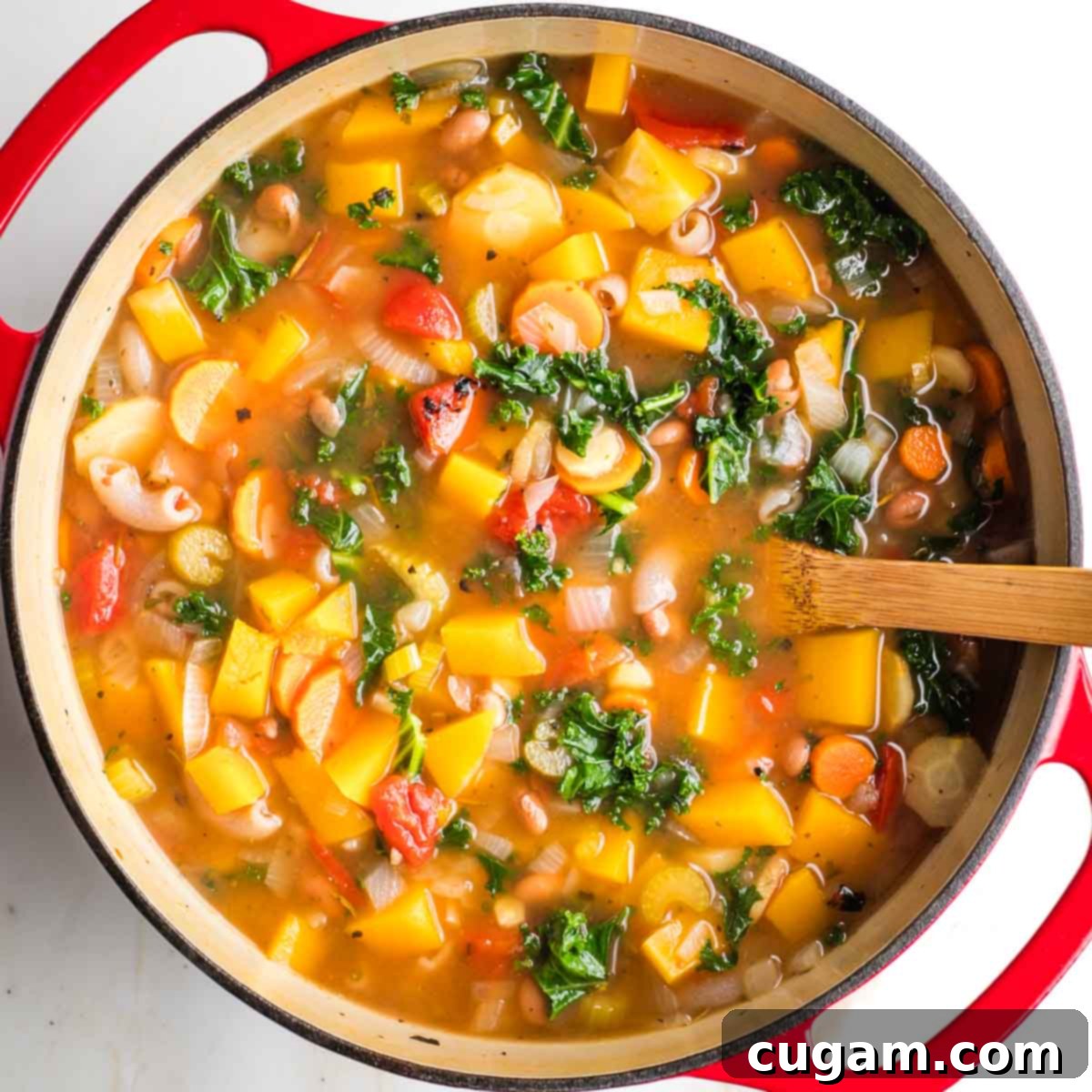
Continue to stir the soup until all ingredients are thoroughly heated through and the kale has beautifully wilted into the rich broth. This usually takes just a few minutes. Finally, taste the soup for seasoning. Adjust with more salt and freshly ground black pepper as needed. For those who enjoy a little kick, sprinkle in some crushed red pepper flakes or a dash of cayenne pepper for a bit of heat. Serve hot and enjoy your homemade, comforting Fall Minestrone!
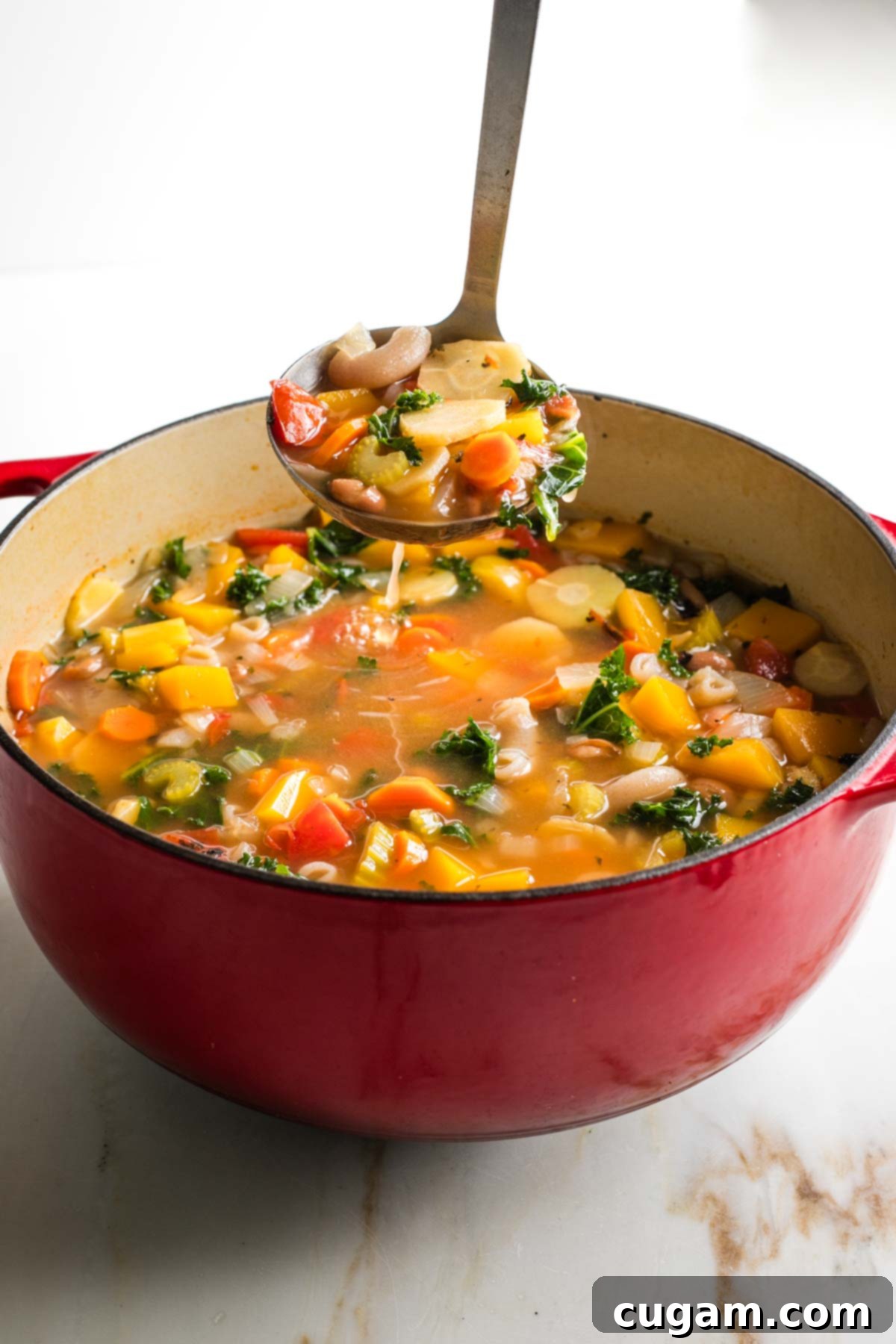
Debra’s Pro Tips for the Best Minestrone
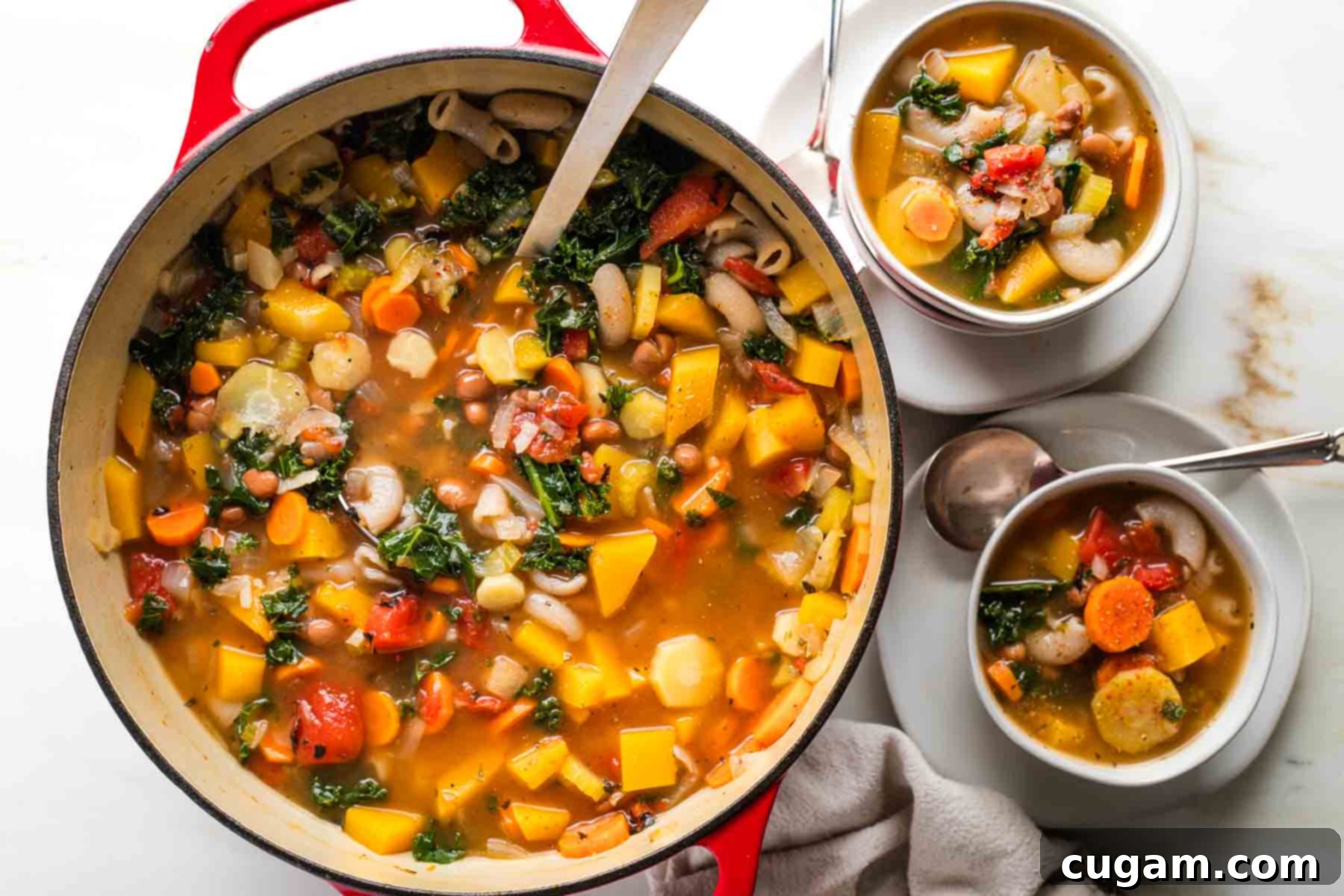
Achieve minestrone perfection with these expert tips, designed to enhance flavor, texture, and convenience:
- Perfect Pasta Texture: To prevent your pasta from becoming a soggy mess, always cook it separately until just al dente. This means it should be firm to the bite. Begin testing for doneness about 2 minutes before the package directions indicate, especially if you’re using gluten-free pasta, which can sometimes cook faster or become mushy more quickly. Add the cooked pasta to the soup only when you’re ready to serve, or for the last few minutes of simmering to heat through.
- Control Your Sodium: For the most flavorful and healthiest soup, I highly recommend using my easy recipe for homemade vegetable broth. This allows you complete control over the amount of salt in your soup, which is crucial for those monitoring their sodium intake. If you’re using a store-bought, boxed veggie broth, be aware that many brands are quite high in sodium, meaning your soup may not be a low-sodium option unless you specifically choose an unsalted variety. Always taste and adjust salt sparingly.
- Add a Spicy Kick: If you enjoy a bit of heat in your soup, there are several ways to elevate the spice level. Sprinkle in some crushed red pepper flakes during the sautéing stage for a gentle warmth throughout, or add a dash of cayenne pepper at the end. For a more intense, bright heat, a squirt of sriracha stirred into individual bowls just before serving works wonderfully. You could also try a pinch of smoked paprika for a hint of smoky spice.
- Storage and Meal Prep: This Fall Minestrone is fantastic for meal prepping! Store leftover soup in an airtight container in the refrigerator for up to a week. It also freezes beautifully for up to 3 months. Be aware that the pasta will continue to absorb liquid as the soup sits, especially if stored together. When reheating, you might need to add a splash more vegetable broth or water to reach your desired consistency. If meal prepping for a week, consider storing the cooked pasta separately and adding it to individual portions upon reheating to maintain optimal texture.
Did you know commenting and rating recipes is one of the best ways to support your favorite food bloggers? If you made this delicious Fall Minestrone Soup, please consider leaving a five-star rating below and sharing your thoughts in the comments. Your feedback truly helps! Also, we’d love to see your culinary creations! Please share your photos on Instagram by tagging me @dkhealthcoach and using the hashtag #debraklein.
📖 Recipe: Fall Harvest Minestrone Soup
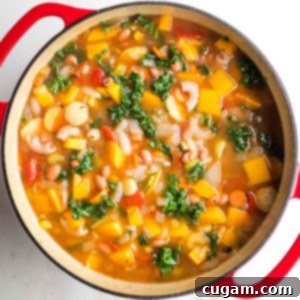
Fall Harvest Minestrone Soup
Debra Klein
Rate this Recipe
📌Pin Recipe
🕒
10
30
40
🥣
Soup
American, Italian
🍽️
6 Servings
185 kcal
Ingredients
Instructions
-
Prepare your vegetables: Dice the yellow onion. Thinly slice the celery, carrots, and parsnips. Peel the butternut squash, remove seeds, and dice into small, uniform cubes (about ¼ inch). Peel the garlic cloves and prepare them for grating or pressing. Wash, de-stem (remove thick ribs), and roughly chop the kale.
-
Sauté the aromatics: Heat your Dutch oven or large soup pot over medium heat. Add 1 tablespoon of olive oil or a splash of veggie broth. Sauté the diced onions for about 3 minutes until they begin to soften and become translucent. Add the carrots, celery, parsnips, Italian spices, and ½ teaspoon of sea salt. Cook, stirring occasionally, for about 5-7 minutes, until the vegetables are tender-crisp. Add veggie broth 1 tablespoon at a time, as needed, to prevent the pan from becoming too dry and the vegetables from burning.
-
Build the soup base: Using a microplane or garlic press, zest the prepared garlic directly into the pot and mix well. Cook for just about 30 seconds until fragrant, being careful not to burn the garlic. Immediately add the canned diced tomatoes (with their juices), the diced butternut squash, the 2 bay leaves, and the 8 cups of veggie stock. Mix everything thoroughly, bring to a gentle boil, then reduce the heat to a simmer and cook for 20 minutes, or until the squash is tender when pierced with a fork.
-
Cook the pasta: Meanwhile, cook the ¾ cup of pasta according to package directions in a separate pot of salted water until it is al dente (firm to the bite). For example, if using cassava flour gluten-free pasta, it typically cooks for about 8 minutes. If you prefer to cook the pasta directly in the soup pot, you will need to add an additional 2 cups of liquid (more broth or even water is fine) to account for absorption, and add it during the last 8-10 minutes of the soup’s simmering time.
-
Final additions: Once the squash is tender, stir in the separately cooked and drained pasta and the rinsed and drained kidney beans to heat through. Turn off the heat. Add the chopped kale and continue to stir until it has wilted into the warm soup.
-
Season and serve: Taste the soup for seasoning and adjust with more salt and freshly ground black pepper to your preference. Remove the bay leaves before serving. Serve hot and enjoy!
-
Storage: Leftover soup will stay good in an airtight container in the fridge for up to a week, or in the freezer for up to 3 months. The pasta will absorb liquid as the soup sits, so be prepared to add more stock or water when reheating as needed to restore the desired consistency.
Notes
*Pasta: For dietary restrictions or preferences, use gluten-free pasta. To achieve the best texture, always cook the pasta separately until al dente and ensure to check for doneness about 2 minutes before the package instructions suggest, as gluten-free varieties can cook quickly.
Nutrition
Serving: 2 cups
Calories: 185 kcal
Carbohydrates: 41 g
Protein: 5 g
Fat: 1 g
Saturated Fat: 0.2 g
Polyunsaturated Fat: 0.3 g
Monounsaturated Fat: 1 g
Sodium: 225 mg
Potassium: 795 mg
Fiber: 7 g
Sugar: 8 g
Vitamin A: 17393 IU
Vitamin C: 44 mg
Calcium: 112 mg
Iron: 2 mg
Disclaimer: Note on Nutrition
The nutrition calculations provided here were generated using online tools and are estimates. To obtain the most accurate representation of the nutritional information for any given recipe, you should calculate the nutritional information with the exact ingredients and brands you use. You are ultimately responsible for ensuring that any nutritional information you rely upon is accurate, complete, and useful for your specific dietary needs.
Did you make this recipe?
Please leave a review below, then snap a picture and tag me @dkhealthcoach or use hashtag #dkhealtcoach on Instagram so I can see it!!
